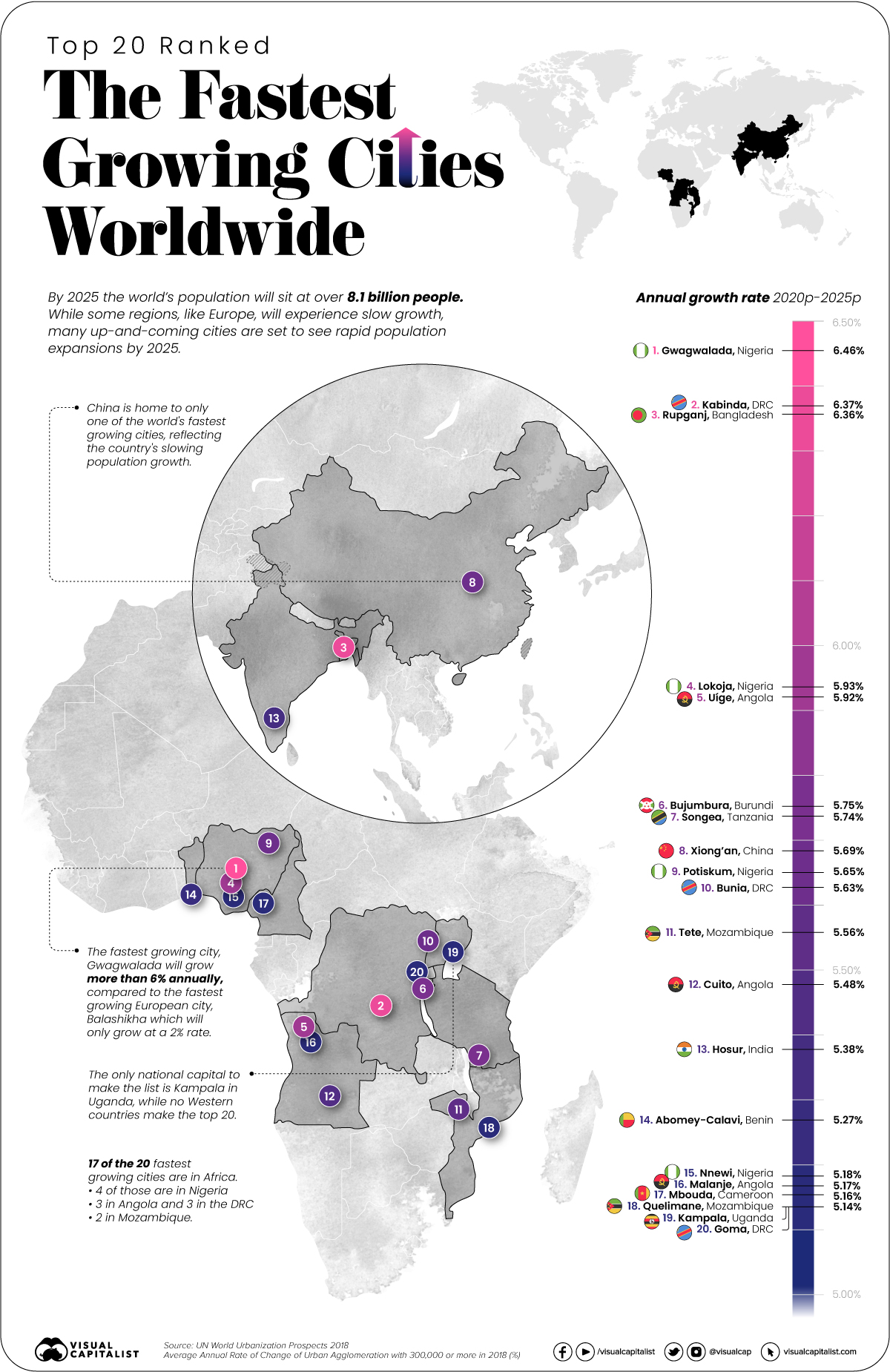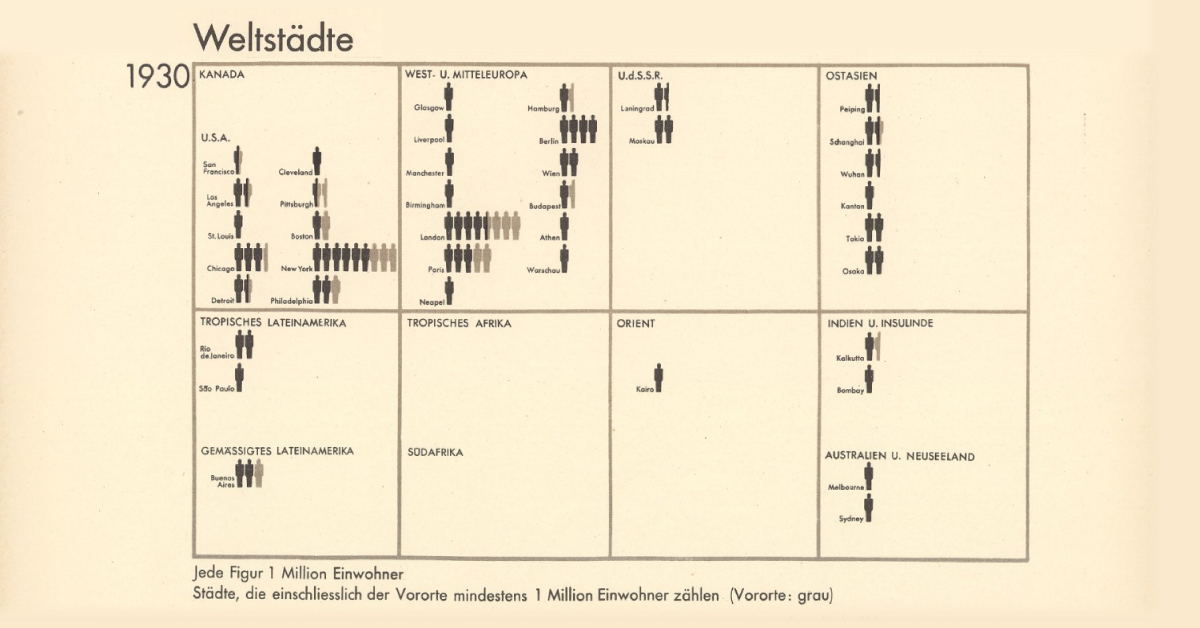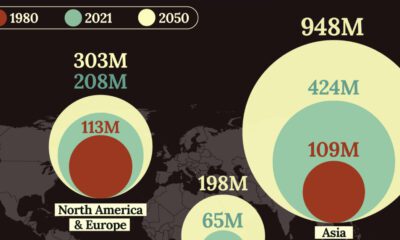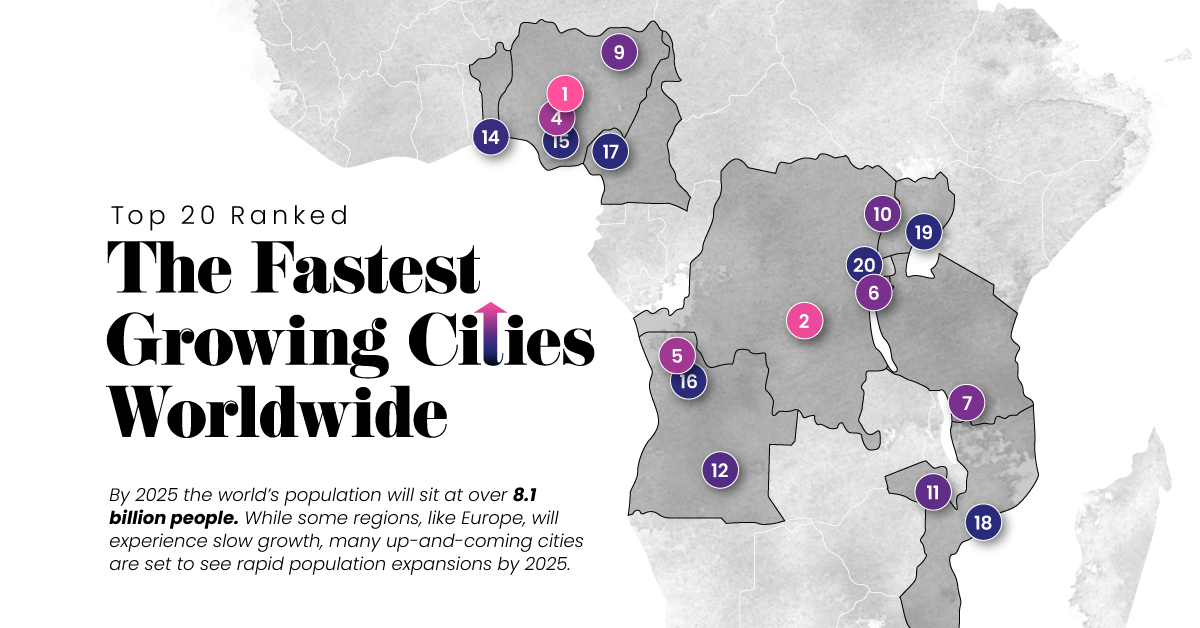Urbanization
Ranked: The World’s Fastest Growing Cities

Ranked: The World’s Fastest Growing Cities
By 2025, the world’s population will reach over 8.1 billion people.
Most of that population growth will be concentrated in cities across Africa and Asia. To help paint a detailed picture, this map uses data from the United Nations to rank the top 20 fastest growing cities in the world in terms of average annual growth rate from 2020 to 2025.
Full Speed Ahead
The majority of the world’s fastest growing cities are located in Africa—in fact, 17 of the 20 are located on the continent, with four of the 20 cities being located in Nigeria specifically.
Population growth is booming across the entire continent, as many countries retain high birth rates. According to the World Bank, the 2019 fertility rate (births per woman) in Sub-Saharan Africa was 4.6, compared to the global fertility rate of 2.4.
| City | Country | Continent | Annual Growth (2020-2025p) |
|---|---|---|---|
| Gwagwalada | 🇳🇬 Nigeria | Africa | 6.46% |
| Kabinda | 🇨🇩 Democratic Republic of Congo | Africa | 6.37% |
| Rupganj | 🇧🇩 Bangladesh | Asia | 6.36% |
| Lokoja | 🇳🇬 Nigeria | Africa | 5.93% |
| Uige | 🇦🇴 Angola | Africa | 5.92% |
| Bujumbura | 🇧🇮 Burundi | Africa | 5.75% |
| Songea | 🇹🇿 Tanzania | Africa | 5.74% |
| Xiongan | 🇨🇳 China | Asia | 5.69% |
| Potiskum | 🇳🇬 Nigeria | Africa | 5.65% |
| Bunia | 🇨🇩 Democratic Republic of Congo | Africa | 5.63% |
| Tete | 🇲🇿 Mozambique | Africa | 5.56% |
| Cuito | 🇦🇴 Angola | Africa | 5.48% |
| Hosur | 🇮🇳 India | Asia | 5.38% |
| Abomey-Calavi | 🇧🇯 Benin | Africa | 5.27% |
| Nnewi | 🇳🇬 Nigeria | Africa | 5.18% |
| Malanje | 🇦🇴 Angola | Africa | 5.17% |
| Mbouda | 🇨🇲 Cameroon | Africa | 5.16% |
| Quelimane | 🇲🇿 Mozambique | Africa | 5.14% |
| Kampala | 🇺🇬 Uganda | Africa | 5.14% |
| Goma | 🇨🇩 Democratic Republic of Congo | Africa | 5.14% |
Nigeria’s economy is largely based on petroleum which has resulted in the country becoming one of the strongest economies in Africa. This, coupled with a high birth rate and a resulting young population, has given the country a strong and rising workforce.
However, the population growth in Nigeria is both a blessing and a curse. The success of the economy, among other factors, has resulted in excessive rural-to-urban migration. This mass exodus from rural areas has led to less farming, which means the country now needs to import basic food staples at a high cost.
In Mozambique, Tete and Quelimane are growing 5.56% and 5.14% respectively. The country is expected to experience strong economic growth after facing contractions due to the pandemic. Forecasts predict that the Mozambiques’s economy will grow 4% by 2022.
Implications of Fast Growth
All of the top 20 fastest growing cities are located in either Africa or Asia, and they are far outpacing growth on other continents, such as Europe, for example.
Fastest Growing Cities: Europe vs. Global
| Europe's Fastest Growing Cities | Growth Rate | World's Fastest Growing Cities | Growth Rate |
|---|---|---|---|
| 🇷🇺 Balashikha, Russia | 2.01% | 🇳🇬 Gwagwalada | 6.46% |
| 🇷🇺 Tyumen, Russia | 1.88% | 🇨🇩 Kabinda | 6.37% |
| 🇦🇱 Tiranë (Tirana), Albania | 1.63% | 🇧🇩 Rupganj | 6.36% |
| 🇳🇴 Oslo, Norway | 1.38% | 🇳🇬 Lokoja | 5.93% |
| 🇷🇺 Sochi, Russia | 1.33% | 🇦🇴 Uige | 5.92% |
| 🇬🇧 Coventry-Bedworth, UK | 1.32% | 🇧🇮 Bujumbura | 5.75% |
| 🇸🇪 Stockholm, Sweden | 1.25% | 🇹🇿 Songea | 5.74% |
| 🇨🇭 Lausanne, Switzerland | 1.23% | 🇨🇳 Xiongan | 5.69% |
| 🇷🇺 Krasnodar, Russia | 1.22% | 🇳🇬 Potiskum | 5.65% |
| 🇷🇺 Surgut, Russia | 1.17% | 🇨🇩 Bunia | 5.63% |
| 🇷🇺 Podolsk, Russia | 1.16% | 🇲🇿 Tete | 5.56% |
| 🇮🇪 Dublin, Ireland | 1.12% | 🇦🇴 Cuito | 5.48% |
| 🇬🇧 London, UK | 1.12% | 🇮🇳 Hosur | 5.38% |
| 🇳🇱 Utrecht, Netherlands | 1.11% | 🇧🇯 Abomey-Calavi | 5.27% |
| 🇸🇪 Göteborg, Sweden | 1.07% | 🇳🇬 Nnewi | 5.18% |
| 🇫🇷 Toulouse, France | 1.07% | 🇦🇴 Malanje | 5.17% |
| 🇸🇪 Malmö, Sweden | 1.05% | 🇨🇲 Mbouda | 5.16% |
| 🇫🇷 Montpellier, France | 1.04% | 🇲🇿 Quelimane | 5.14% |
| 🇫🇷 Bordeaux, France | 0.99% | 🇺🇬 Kampala | 5.14% |
| 🇨🇭 Genève, Switzerland | 0.99% | 🇨🇩 Goma | 5.14% |
By 2050, Sub-Saharan Africa will be home to close to 2 billion people and roughly half will be under the age of 25. This represents an enormous labor force and opportunities for innovation and growth. In fact, in navigating the pandemic, Africa is already starting to capitalize on digital advances in both traditional and new sectors.
China has its eye on Africa, as evidenced through their multiple investments in infrastructure projects in the continent. Additionally, NATO countries have recently committed to investing similar amounts in Africa to counter China’s influence.
In spite of the economic potential, increased city sizes could be problematic for some of these countries. They will need to adapt to the issues associated with mass urbanization, like pollution, overcrowding, and high costs of living.
Changing Tides
Population booms can lead to massive economic growth, a larger (and younger) working population, and a growing domestic consumer market.
As the aforementioned cities continue their rapid expansion, and as people continue to flock to growing megacities in Africa and Asia, it could represent the beginning of an important economic shift that is worth keeping an eye on.
population
Vintage Viz: World Cities With 1 Million Residents (1800–1930)
From someone born in the 19th century, in the midst of historic population growth, comes this vintage visualization showing world cities growing ever bigger.

World Cities With At Least 1 Million Residents (1800–1930)
This chart is the latest in our Vintage Viz series, which presents historical visualizations along with the context needed to understand them.
The explosive world population boom in the last 300 years is common knowledge today. Much and more has been written about how and why it happened, why it was unusual, and how the specter of a declining population for the first time in three centuries could impact human society.
However, equally compelling, is how people in the past—those living in the midst of the early waves of this boom—were fascinated by what they were witnessing.
Evidence of this comes from today’s vintage visualization, denoting the increasing number of world cities with at least one million inhabitants through the years.
The above pictogram was made by Austrian philosopher and sociologist Otto Neurath (1882–1945), found in his book, Society and Economy, published in 1930.
World Population Doubles Between 1800 and 1930
In 1800, the world population crossed 1 billion for the first time ever.
In the next 130 years, it doubled past 2 billion.
The Second Agricultural Revolution, characterized by massive land and labor productivity, grew agricultural output more than the population and is one of the key drivers of this population growth.
And in the pictogram above, where one silhouette indicates one million inhabitants, this exponential population growth becomes far more vivid.
In 1800, for example, according to the creator’s estimates, only London had at least million residents. A century later, 15 cities now boasted of the same number. Then, three decades hence, 37 cities across the world had one million inhabitants.
| Year | Cities with One Million Residents |
|---|---|
| 1800 | 1 |
| 1900 | 15 |
| 1930 | 37 |
Importantly, the data above is based on the creator’s estimates from a century ago, and does not include Beijing (then referred to as Peking in English) in 1800. Historians now agree that the city had more than a million residents, and was the largest city in the world at the time.
Another phenomenon becoming increasingly apparent is growing urbanization—food surplus frees up large sections of the population from agriculture, driving specialization in other skills and trade, in turn leading to congregations in urban centers.
Other visualizations in the same book covered migration, Indigenous peoples, labor, religion, trade, and natural resources, reflecting the creator’s interest in the social life of individuals and their well-being.
Who Was Otto Neurath and What is His Legacy?
This vintage visualization might seem incredibly simple, simplistic even, considering how we map out population data today. But the creator Otto Neurath, and his wife Marie, were pioneers in the field of visual communication.
One of their notable achievements was the creation of the Vienna Method of pictorial statistics, which aimed to represent statistical information in a visually accessible way—the forerunner to modern-day infographics.
The Neuraths believed in using clear and simple visual language to convey complex information to a broad audience, an approach that laid the foundation for modern information design.
They fled Austria during the rise of the Nazi regime and spent their later years in various countries, including the UK. Otto Neurath’s influence on graphic design, visual communication, and the philosophy of language has endured, and his legacy is still recognized in these fields today.
-

 Business2 weeks ago
Business2 weeks agoAmerica’s Top Companies by Revenue (1994 vs. 2023)
-

 Environment2 weeks ago
Environment2 weeks agoRanked: Top Countries by Total Forest Loss Since 2001
-

 Real Estate2 weeks ago
Real Estate2 weeks agoVisualizing America’s Shortage of Affordable Homes
-

 Maps2 weeks ago
Maps2 weeks agoMapped: Average Wages Across Europe
-

 Mining2 weeks ago
Mining2 weeks agoCharted: The Value Gap Between the Gold Price and Gold Miners
-

 Demographics2 weeks ago
Demographics2 weeks agoVisualizing the Size of the Global Senior Population
-

 Automotive2 weeks ago
Automotive2 weeks agoTesla Is Once Again the World’s Best-Selling EV Company
-

 Technology2 weeks ago
Technology2 weeks agoRanked: The Most Popular Smartphone Brands in the U.S.












